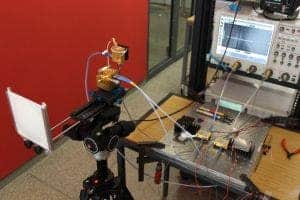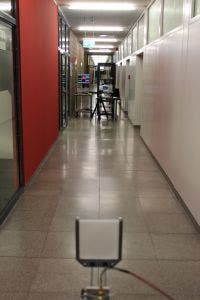German researchers at the Karlsruhe Institute of Technology (KIT) have achieved a new world record for wireless data transmission after they successfully reached 100 gigabits/second over a distance of 20 meters and at a frequency of 237.5 GHz. This translates into a transfer rate of 12.5 gigabytes per second – equivalent to exchanging the contents of a blue-ray disk or of five DVDs between two devices by radio within two seconds only! The previous record, achieved by the same KIT researchers, was of 40 Gbps.
For their experiment, the scientists used the latest photonic and electronic technologies. First, the radio signals are generated by means of an optical method, which involves superimposing two laser signals of different frequencies. The resulting electrical signal has a frequency equal to the frequency difference of the two optical signals – 237.5 GHz. Several bits are combined by so-called data symbols and transmitted at the same time. Upon transmission, the radio signals are received by active integrated electronic circuits.

The radio signals are transmitted using an ultra-broadband so-called photon mixer made by the Japanese company NTT-NEL. The millimeter-wave electrical signal is then radiated via an antenna, while a semiconductor chip that can cope with advanced modulation formats, like these huge working frequencies, translates the signal. As a result, the radio link can be integrated into modern optical fiber networks in a bit-transparent way.
“It is a major advantage of the photonic method that data streams from fiber-optical systems can directly be converted into high-frequency radio signals,” Professor Jürg Leuthold says. He proposed the photonic extension that was realized in this project. The former head of the KIT Institute of Photonics and Quantum Electronics (IPQ) is now affiliated with ETH Zurich. “This advantage makes the integration of radio relay links of high bit rates into optical fiber networks easier and more flexible.“ In contrast to a purely electronic transmitter, no intermediate electronic circuit is needed. “Due to the large bandwidth and the good linearity of the photon mixer, the method is excellently suited for transmission of advanced modulation formats with multiple amplitude and phase states. This will be a necessity in future fiber-optical systems,” Leuthold adds.

The research was part of the “Millilink” project which aims to bring broadband internet connections to rural and under-connected areas.
“Our project focused on integration of a broadband radio relay link into fiber-optical systems,” Professor Ingmar Kallfass says. He coordinated the “Millilink” project under a shared professorship funded by the Fraunhofer Institute for Applied Solid State Physics (IAF) and the Karlsruhe Institute of Technology (KIT). Since early 2013, he has been conducting research at Stuttgart University. “For rural areas in particular, this technology represents an inexpensive and flexible alternative to optical fiber networks, whose extension can often not be justified from an economic point of view.”
The KIT researchers are confident they can scale their technique and increase data rate even further. They consider a 1 terabit per second transfer to be feasible!
“By employing optical and electrical multiplexing techniques, i.e., by simultaneously transmitting multiple data streams, and by using multiple transmitting and receiving antennas, the data rate could be multiplied,” says Swen König from the KIT Institute of Photonics and Quantum Electronics (IPQ), who conceived and conducted the recent world-record experiment. “Hence, radio systems having a data rate of 1 terabit per second appear to be feasible.”
Findings were reported in Nature Photonics.







